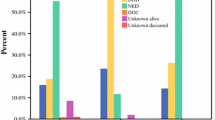Abstract
Oncologic emergencies have been extensively described and clearly defined. In oncology daily practice, cancer patients seek nonscheduled medical care in situations they perceive as a medical emergency, but which may not be a true emergency. The aim of the study was to identify the main symptoms leading to a nonscheduled consultation (NSC) and their relationship to the type of cancer, and to evaluate whether the diagnosis at discharge of patients admitted as result of a NSC correlates with a true oncologic emergency. This was a prospective observational study. Between July 2002 and April 2003, 365 NSCs were recorded. The most frequent baseline diseases were breast cancer (70), lung cancer (67), gastrointestinal cancer (52), lymphoma (42) and ovarian cancer (22). The most common symptoms for consultation were: fever (84), pain (81), cutaneous manifestations (26), dyspnea (23), bleeding (16) and abdominal distention (16). Overall, 114 of 365 NSCs (31%) resulted in admission. The most frequent symptoms resulting in admission were fever (42), pain (16), dyspnea (11), vomiting (9), neurologic manifestations (7), abdominal distention (6) and anuria (6). At discharge, only 30 patients (26%) admitted after a NSC were diagnosed with a defined oncologic emergency: febrile neutropenia (13), intestinal occlusion (12), obstructive uropathy (4) and abdominal perforation (1). True emergencies were not the most frequent causes of NSC at our institution.
Similar content being viewed by others
References
Adam J (1997) ABC of palliative care. The last 48 hours. BMJ 315:1600–1603
Bates S, Kleave C, Crowther M, et al (2003) A diagnostic strategy involving a quantitative Latex d-dimer assay reliably excludes deep venous thrombosis. Ann Intern Med 138:787–794
Birdwell BG, Raskob GE, Whitset TL, et al (1998) The clinical validity of normal compression ultrasonography in outpatients suspected of having deep vein thrombosis. Ann Intern Med 128:1–7
Chiu TY, Hu WY, Chen CY (2000) Prevalence and severity of symptoms in terminal cancer patients: a study in Taiwan. Support Care Cancer 8:311–313
Falk S, Fallon M (1997) ABC of palliative care. Emergencies. BMJ 315:1525–1528
Hahn SM (2000) Oncologic emergencies. In: Goldman L, Bennett JC (eds) Cecil textbook of medicine. WB Saunders, Philadelphia, pp 1074–1076
Levy MH (1996) Pharmacological treatment of cancer pain. N Engl J Med 335:1124–1131
World Health Organization (2003) Cancer by the numbers. Global cancer rates could increase by 50% to 15 million by 2020. http//:www.who.int/mediacentre/releases/2003/pr27/en/
Yahalom J, Fuller BG, Heiss JD, et al (2001) Oncologic emergencies. In: DeVita VT Jr, Hellman S, Rosenberg S (eds) Cancer principles and practice of oncology. Lippincott Williams and Wilkins, Philadelphia, pp 2609–2653
Acknowledgements
We thank G. Kusminsky and C. Gimpelewicz for reviewing the manuscript.
Author information
Authors and Affiliations
Corresponding author
Rights and permissions
About this article
Cite this article
Díaz-Couselo, F.A., O’Connor, J.M., Nervo, A. et al. Nonscheduled consultation in oncologic patients. How many of them are true emergencies? An observational prospective study. Support Care Cancer 12, 274–277 (2004). https://doi.org/10.1007/s00520-003-0584-z
Received:
Accepted:
Published:
Issue Date:
DOI: https://doi.org/10.1007/s00520-003-0584-z




